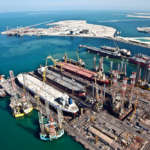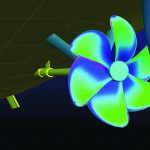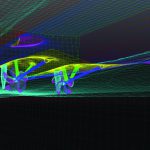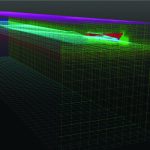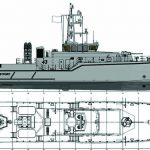Nowadays propulsion systems of ships were mostly designed by a combination of
computational design by analysis methods coupled with systematic validation tests
at both model and full scale.
This article details the design and development of an optimized propulsion system for the 43 m long patrol boat design[ds_preview] Global Response Cutter (GRC) by Westport Shipyard (see figure 1). The propulsion system was designed by Maritime Research Associates with the propeller and struts built by Michigan Wheel Marine, and the rudders by Westport Shipyard. The propulsion system design effort was funded jointly by MTU Detroit Diesel and Westport Shipyard.
The GRC 43 is a state-of-the-art patrol vessel, complying with the American Bureau of Shipbuilding (ABS) standards for high-speed crafts. The vessel, built in response to anticipated worldwide demands for a fast response cutter, is constructed entirely from composite materials. Innovative design and manufacturing techniques have resulted in a vessel that is on-time, on-budget and as-promised. Among other technologies, Computational Fluid Dynamics (CFD) played a major role in the vessel’s design. CFD was used to design an optimized strut-rudder-propeller system that efficiently interacts with the GRC hull form.
Marine propulsion system design – an overview
The main components of a propulsion system are the power plant, transmission, and propulsor. With an ever-increasing demand for both larger and faster vessels, optimized propeller design is integral to maximizing performance which can be characterized generally by increasing efficiency. This increase in efficiency for given vessel speed leads to a lowering of fuel costs via minimizing power consumption.
Conversely, for given power, increased efficiency maximizes vessel speed. In addition, the demands of noise and emission control regulations require better selection and interaction of the propellers with the ship as a system. There are different motivations for propeller design based on the requirements, which in addition to propeller efficiency discussed above also include noise and vibration control, avoidance of erosive cavitation, and minimum environmental impact.
Collectively, a comprehensive approach to all of these areas leads to reduced risk of poor performance. In the climate of global energy challenges, a key point to reemphasize is that fuel savings is often the predominant consideration for ship operators today.
Driven by commercial pressures, the design of modern propulsion systems have relied less on traditional model tests and moved to a combination of computational design by analysis methods coupled with systematic validation tests at both model and full scale. With the confidence and technological advances in Computer Aided Engineering (CAE) in the marine industry, more and more propulsion systems are being solely designed by analysis, before experimental testing of the final model, potentially resulting in enormous time and cost savings by either reducing or eliminating expensive physical tests. The roles of physical model tests are evolving into more of a tools validation mechanism. In addition, CAE offers a fast, economic method to analyze different propeller configurations and their interactions with the vessel as a whole at full scale, and hence, avoiding the effects of model scaling.
The ultimate aim of any vessel design is to produce: a hull form with minimal resistance subject to seakeeping constraints, a propulsion system that operates efficiently in the wake of the vessel, and a rudder that maneuvers the ship safely. However, these three components cannot be viewed in isolation, as each component also influences the performance of the others in various ways. Reynolds Average Navier Stokes (RANS) solvers can be used for open water propeller analysis, appended resistance tests, and self propulsion analysis, which includes the effects of cavitation.
Westport GRC propeller – a design by analysis
The Westport GRC is a 43 m vessel for littoral and offshore security and patrol. The vessel has a maximum speed of 32.8 kn and a range of 1,000 NM at this speed. The vessel uses two MTU 16V400 engines coupled to five blade propellers, all proven for fast vessels with high load factors and maximum mission availability. The propellers, struts, and rudders were all designed with a wake adapted approach by Maritime Research Associates (MRA), using STAR-CCM+, CD-adapco’s multi-purpose Navier Stokes solver. Some of the key criteria and benefits of the design were:
• fuel savings,
• increased top speed,
• elimination of erosive appendage cavitation,
• noise and vibration reduction.
For a computational analysis, it is paramount to validate the numerical methodology with experimental results to gain full confidence in analysis. STAR-CCM+ is a robust computational code that has been well validated in various application areas pertaining to the marine industry. MRA also has built an in-house computational methodology using STAR-CCM+ after validating the performance of the code against experimental results for various problems.
An example of validation is shown in figure 2. Here, the ability of STAR-CCM+ to accurately predict the performance of the strut-propeller-rudder system was validated against a comprehensive model test program in the depressurized towing tank at the Maritime Research Institute of the Netherlands (MARIN) to gain confidence in and to validate the computational solution strategy. The MARIN program was funded by TY Offshore and MTU Detroit Diesel. A sample image shows comparison between selected experimental and numerical results for the TY Offshore application. Due to the confidence gained from validation studies, the design of the strut, propeller and rudder system were performed largely using STAR-CCM+. The final stages of the design process consisted of ten different propeller designs and five different design iterates each for the struts and rudders, all simulated in STAR-CCM+.
These different combinations were all analyzed in the »behind« or self propulsion configuration. This computational model consisted of the ship hull, appendages, propellers, rudders and struts. A computational domain was built around the model to represent the fluid domains of both liquid and air, with a free surface at the junction of the two fluids. The Volume of Fluid (VOF) method in STAR-CCM+ was used due to the presence of two immiscible fluids. The methods solves for the volume fraction of each fluid in each cell. The free surface is the location where the volume fraction is between zero and one for capturing the interface between the two fluids. The free surface waves are specified in STAR-CCM+ using the VOF waves capability.
The computational domain was discretized into cells of polyhedral and hexahedral shape (as seen in figure 3) and the Navier Stokes equations are solved within each cell for both fluids. The mesh near the free surface was refined sufficiently to resolve the wave height and wavelength. The self propulsion analysis required a stationary outer domain of trimmed hexahedral cells and an inner rotating domain of polyhedral cells.
The inner polyhedral domain defined the propeller geometry, allowing the propeller rotation, and had approximately 1.5 m computational cells. The outer hexahedral domain defined the ship hull, appendages and the surrounding fluids with 1.5 to 2 m cell volumes. A boundary layer mesh consisting of prismatic cells was used to capture the boundary layer of the flow near the solid surfaces. The propulsion tests were conducted by iterating through different combinations of the designs, until all performance requirements were met. The tests were conducted at the maximum speed of 32.5 kn. The optimized design has reduced cavitation and is designed for minimal influence from the propeller wake on cavitation.
Final design
The final optimized design was found to offer excellent fuel savings with an estimated reduction of 11,000 Gal of fuel and cost savings of 44,000 $ per year per vessel when compared with typical commercial off-the-shelf (COTS) technology. There was also an increase of 0.93 kn at top speed which would have required an additional 180 KW per engine if a standard COTS approach had been taken. One of the main parameters used to characterize a ship performance is the quasi-propulsive coefficient, which is the ratio of the effective power to the available brake power at the engines. Performance comparisons were made with COTS propulsion hardware options at three speeds which included loiter at 12 kn, transit at 22 kn, and flank at 32.5 kn.
The fuel cost savings per year from the new design was approximately 11,000 $ per 1 % QPC, leading to a total of 44,000 $ fuel savings from the 4 % QPC savings delivered. The QPC savings also led to a speed gain of 0.22 kn for loiter, 0.72 kn for transit, and 0.93 kn for flank. The optimized design further eliminated cavitation on the strut and the rudder through wake alignment. Additional improvements included a decrease of 40 % in radiated pressure pulse amplitudes, leading to quieter vessels. A fully optimized strut-propeller-rudder system was designed solely based on computational methods with excellent returns in cost, performance, and efficiency. The final vessel is a high quality, cost-effective platform for a demanding patrol boat service.
Engineering company Maritime Research Associates
Maritime Research Associates is a naval architecture and marine engineering company located in the historic Kerrytown district of Ann Arbor, Michigan/USA. MRA spends a great deal of time working for clients in the areas of basic and applied numerical hydrodynamic research and development that span all sectors of the marine industry.
In recent years, the emphasis on numerical development of hullform and propulsor systems, using computational domains that mirror the towing tanks and cavitation tunnels of traditional experimental facilities of the world, has continued to grow in project number and project breadth.
As per processor cost continues to decrease, coupled with the stable, validated and verified tools such as STAR-CCM+, the trend toward greater emphasis on numerical development of marine systems will continue to expand into the future. All hydrodynamic development efforts at MRA are lead by Brant R. Savander.
Brant R. Savander, Prashanth Shankara






